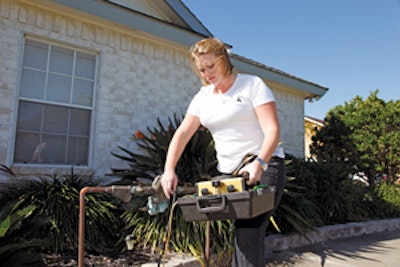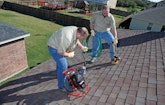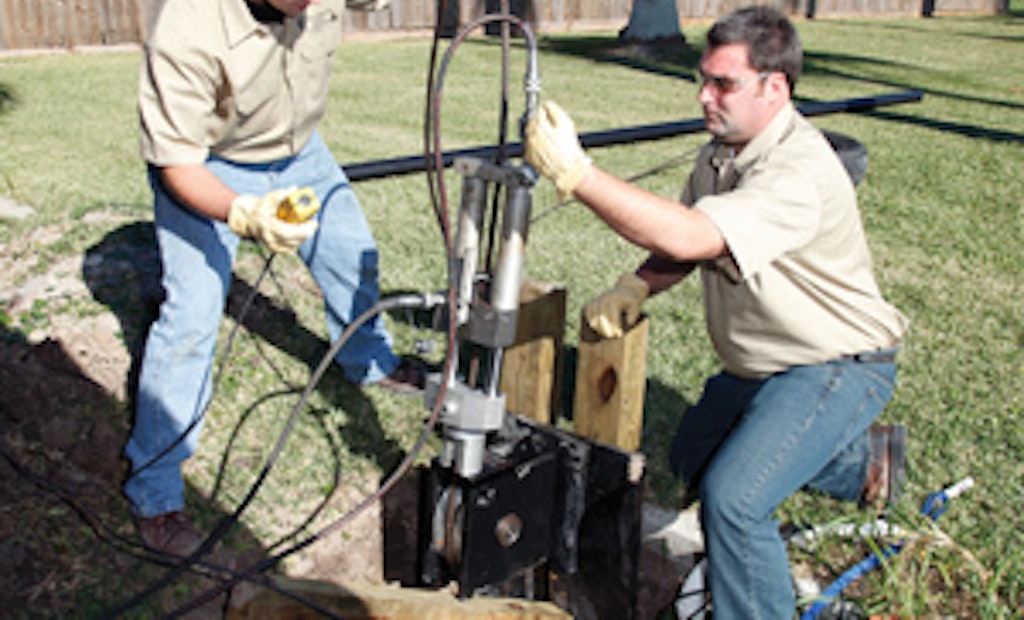Interested in Cleaning?
Get Cleaning articles, news and videos right in your inbox! Sign up now.
Cleaning + Get AlertsPaul Simons, with his master plumber license and his wife Neatha, opened Hurricane Drain in Corpus Christi in 2000. The plan was to offer basic repairs and drain cleaning.
It wasn’t until 2004 that Simons found the service that would define the company and drive the bottom line. Simons visited the booth of the Underground Utilities and Leak Locators Association (UULLA) at the 2004 Pumper & Cleaner Environmental Expo and joined that organization. He checked out the required equipment and the process and decided that adding that capability to drain cleaning would help him grow.
By the end of 2010, line locating, leak detection and testing had grown 20 percent of total revenue. It was also the signature offering that brought a large share of other work for Hurricane Drain. The core business focuses on contracting with other plumbers and working directly with real estate agents.
The crew swelled to nine as son Derek Simons, also a master plumber, came on board. He oversees all repair work and acts as liaison between customers and crews. Son-in-law Daniel Wildenhaus manages the recently added cured-in-place pipe (CIPP) service line, and daughter Katrina Newsom is a licensed backflow tester.
Pipe bursting is directed by employee Justin Portier, and Aaron Simons, Paul’s brother, handles general office duties. Neatha Simons takes care of financials. Locating and leak detection remain under Paul Simons’ purview because he enjoys the work and has the relationships with clients for that service.
Right for the times
In Corpus Christi and surroundings, Hurricane Drain deals with failed residential water and sewer with broken pipes, often caused by expansive soil. The firm sees 2- to 4-inch cast-iron and clay pipe and, in newer construction PVC.
“When there is drought, the soil will shrink rapidly, and when there is moisture, the soil expands,” says Simons. “All this causes cracks and breaks. Crews also have to contend with the effects of hurricanes, and in 2010, rainfall totaled 42 inches.
“There is a lot of root intrusion,” Simons says. “Every tree in the neighborhood takes a drink off the sewer pipes. When there is a problem with a water line, it is evident. There is water coming out where it should not be. The water bill is too high. Sewer lines have to be tested to be sure they are intact. In every real estate transaction, lenders in the area demand a hydrostatic test, and it is pass or fail. If the pipe doesn’t get a passing report, we go to an isolation test to find the problem. You can’t have broken sewer pipe in the state of Texas.”
Hydrostatic testing involves introducing water to the required pressure to ensure that the pipe will not leak or be damaged. Isolation testing involves inserting plugs into the system, then checking with a camera to discover exactly where the problem is located.
Simons does the testing and prepares the reports, which must be accurate. Lenders usually require three repair bids based on his design. Hurricane often bids for the work, but the lowest figure gets the job. “We probably get 80 percent of the jobs with our bid, following our inspection,” Simons says.
“When we do a report, for the most part contractors can bid right off the drawing. I have notes to describe the closest area if there has to be a tunnel from one point to another. If there are obstacles in the way to the lines, there might be suggestions to use the opposite side of the house, or other options.”
When tunneling is required, any soil removed must be hauled away. It is replaced with an engineered building mix of sand and clay that will bind and retain its volume. Hurricane Drain engages an engineer when required on tunneling jobs.
Tools of the trade
The company uses equipment from RIDGID including five SeeSnake Compact cameras, a Mini-SeeSnake Plus, and a SeeSnake microDrain inspection system. Locating equipment includes three NaviTrack units from RIDGID and one Goldak Triad Digital 2310.
For jetting there is one trailer mounted (4,000 psi/20 gpm) jetter with a camera and recording equipment along with two Spartan jetters (one gasoline, one electric). For the isolation tests, Simons uses test plugs from Cherne Industries. For water supply testing, he uses the Pulsar 2000 system, and for smoke testing he has a Power Smoker from Hurco Technologies.
Fleet vehicles include Simons’ 2006 Dodge Sprinter 2500 diesel truck, a 2008 Chevrolet 1500 pickup, a 2008 Chevrolet three-quarter-ton van, and a 2005 half-ton Ford Ranger.
Backflow testing is an essential part of the menu. “Anytime you are using city water, there is the possibility of backflow into the water line, and the line must be certified in all real estate transactions,” says Simons. “This requires a backflow prevention device.” His daughter Katrina Newsom takes care of those requirements.
About half of the leak detection and locating work is for real estate agents. Work for other plumbers is on a subcontract basis, and Hurricane Drain never competes for those plumbers’ customers. For testing and reports, Simons provides the drawings to the other company and will perform other services if asked. The majority of work is in residential.
Precise reporting
Hurricane Drain does not solicit or advertise the service but will respond to customers who pick up a phone number from a truck and call.
Sometimes engineers request locating and leak detection when there are foundation problems in a building and bad plumbing is known to be the cause. This calls for hydrostatic and possibly isolation testing. Another issue is mold in the walls fed by moisture from a broken sewer pipe.
Where people are experiencing sewer odors, the company uses smoke testing to find the cause. Simons has the homeowner stand in the room where the problem seems to be and watch for a waft from the floor or through a sliding door.
Again, precision reports and drawings are essential. “You have to have plumbing design experience to know what you are testing and recording in order to understand how the plumbing is run,” Simons says. “With a camera, you see what you are blocking off and what is being tested. You have to know there is not another leak. You have to report everything and commit to your findings in writing on the drawing.”
When the time is right
Last year, Simons again saw a need to expand the services while maintaining the same customer base. In mid-2010 Hurricane Drain added CIPP lining technology from Nu Flow Technologies and pipe bursting equipment from TRIC Tools.
CIPP saw significant growth from the start, but Simons believes pipe bursting generated the greatest interest. “We’re expecting this line of repair to go crazy in the future,” he says. “We will be buying more equipment and expect to be doing larger lines.”
When subcontracting these services to other plumbers, the plumbing company does the preliminary work of trenching and access pits. Hurricane Drain then does its work, and the plumbing company finishes up. Where Hurricane Drain is the prime contractor, the company subs out any engineering, tunneling and related tasks.
Hurricane Drain always strives to work better and smarter. “We look for ways to help the customer understand the impact of having trucks in the driveway,” says Simons. “When we are the contractor, we want to be able to walk away with everything looking nice and the homeowner happy.”
Poised for performance
As the company approached 2011, Simons was considering retiring its vehicles and standardizing on 12- to 14-foot vans in a heavier-duty configuration. The trucks would carry more equipment and provide more advertising space on the sides. The firm was also looking at a policy of retiring service trucks at 100,000 miles.
Getting involved with the UULLA gave Hurricane Drain the encouragement to carve out a new niche in the market. Locating, leak detection and testing became vital to the business. “It is so important in our total operation,” Simons says. “It brings in other business and thus keeps us busy all the time.”










